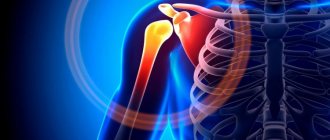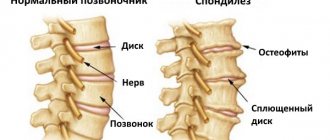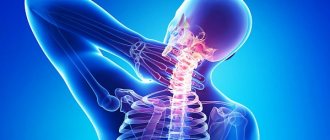Intercostal chondrosis is the initial stages of osteochondrosis of the thoracic spine. The pathology is characterized by a slow course, accompanied by the gradual destruction of cartilage tissue. Its danger lies in mild symptoms, the intensity of which increases as the intervertebral discs are damaged. The leading symptom of chondrosis is intercostal neuralgia, which occurs when sensitive nerve endings are pinched. Chest pain is sharp, piercing, radiating to the area of the shoulder blade and shoulder. It resembles the pain that occurs with cardiovascular pathologies, which is why most people make an appointment not with a rheumatologist, but with a cardiologist.
To diagnose intercostal chondrosis, various instrumental studies are used, but radiography becomes the most informative. Treatment is aimed at improving the patient’s well-being and preventing further destruction of the intervertebral discs.
The mechanism of pathology development
Osteochondrosis often affects the cervical and lumbosacral spine, but degenerative-dystrophic changes in the thoracic vertebrae are rarely diagnosed. This is explained by the low mobility of this section and good stabilization by the elastic rib frame. Typically, the pathology does not affect the reliably protected intervertebral discs, but the joints connecting the transverse processes and the cartilaginous tissue located between the ribs and vertebrae. The disease develops as follows:
- under the influence of dynamic load in cartilage, the rate of tissue breakdown processes begins to exceed the rate of their restoration;
- arthrosis, or chronic degenerative damage to articular cartilage, begins to develop;
- joints lose stability, their functional activity decreases, which causes the involvement of connective tissue structures - ligaments, muscles, tendons - in the pathological process;
- At this stage of intercostal chondrosis, the first symptoms appear: a person feels a certain discomfort when walking and bending over. Since the mobility of the thoracic region is still completely preserved, the patient does not seek medical help;
- Over time, the intensity of pain increases due to deformation of the joint structures. The mobility of the spinal column is limited, and the symptoms of thoracic osteochondrosis are combined with clinical manifestations of intercostal neuralgia.
Typically, intercostal chondrosis is diagnosed at this stage of the course, when destructive changes have affected not only the cartilage, but also the bone tissue of the vertebrae and intervertebral discs. Their nature is irreversible, since hyaline cartilage cannot be restored.
Causes of the disease
The etiology of intercostal chondrosis does not differ from the causes of thoracic osteochondrosis. Injury to this part of the spine often leads to the development of pathology: fractures, severe bruises, prolonged compression of the chest. External and internal negative factors that provoke the disease also include:
- systemic joint pathologies: rheumatoid, psoriatic arthritis, osteoarthritis;
- benign and malignant neoplasms;
- intervertebral hernias localized in any part of the spine;
- diseases associated with metabolic disorders: thyrotoxicosis, gouty arthritis, diabetes mellitus;
- excess weight, which causes excess stress on the intervertebral discs.
The impetus for the development of intercostal chondrosis can be both excessive physical activity and a sedentary lifestyle. The risk group includes people whose professional activities involve lifting and carrying heavy objects.
Intercostal osteochondrosis
Articles / Intercostal osteochondrosis is, although not entirely correct, a fairly common name for intercostal neuralgia. This problem mainly occurs in older people; in young people, this disease is found very rarely. This term itself is generally justified - the cause of neuralgia is usually osteochondrosis of the thoracic spine. And since it is here that the ribs are attached to the spine, the name appeared accordingly.
Why does this disease appear?
In general, osteochondrosis of the thoracic spine is a rather rare phenomenon. This is due to the specifics of this department - it is inactive and the loads that fall on it are small. As a result, it turns out that the load on the intervertebral discs, which are the first to suffer from osteochondrosis, is minimal, and due to low mobility, even the active development of osteophytes may go unnoticed. It is even possible that the entire thoracic spine will be connected by these growths into a single motionless block, and no pain will appear. However, this is an extremely rare situation. Much more often, the development of osteochondrosis makes itself felt over time in the most unpleasant way, but we will talk about this later.
The main reasons for the development of osteochondrosis in the thoracic region, as in other parts of the spine, are metabolic disorders and a lack of vitamins and microelements, which causes degenerative processes in the intervertebral discs, as well as the lack of necessary physical activity. There is no particular point in going deeper into the description of the process of development of osteochondrosis and its consequences; there is enough material on this issue on our website. In this case, we are interested in only one fact - the appearance of a herniated intervertebral disc or osteophytes sooner or later compresses one or several nerve roots of the spine, which leads to the appearance of intercostal neuralgia.
How does this disease manifest itself, what are its symptoms?
Intercostal neuralgia, which often appears during the development of a disease such as osteochondrosis of the thoracic spine, is essentially not an independent disease, it is simply a pain syndrome that is a consequence of the progression of the disease. At the same time, it is this syndrome that leads to the appearance of very severe pain, which is comparable in strength to pain in acute renal colic. When the intercostal nerve is pinched, the pain begins to spread along its course, so it gradually “encircles” the person, without having a clear localization. But at the same time, the pain intensifies towards the spine. In addition, such neuralgia is usually accompanied by a number of sensitivity disorders - numbness or burning may appear along the affected nerve. In this case, the intercostal muscles begin to twitch during an attack, and sweating intensifies.
The skin in the affected area may become paler, or vice versa, acquire a reddish tint. But this is not the only problem that arises with the development of this pain syndrome. Its distinctive feature is also the fact that it successfully simulates pain that arises for completely different reasons, which is why in some cases doctors make incorrect diagnoses. As a result, sometimes the patient undergoes a long course of treatment, which does not help him at all, without realizing that the cause of the pain lies in another plane.
The most problems arise in cases where pain due to neuralgia is similar to pain due to cardiac pathology. In this case, pain occurs in the heart area, which radiates under the shoulder blade, which almost completely corresponds to the clinical picture of angina pectoris. However, an experienced specialist will always determine that the cause is not in the heart, even based on a survey of the patient, since pain with neuralgia has its own specifics. For example, with angina pectoris, an attack of pain usually lasts only a few minutes, but with neuralgia, the pain can last for days.
In addition, with this pain syndrome, the pain usually intensifies when changing body position, sneezing or coughing, taking deep breaths, etc., which is not typical for angina pectoris. In addition, a drug such as nitroglycerin always relieves pain from angina, but cannot cope with neuralgia. Also, intercostal neuralgia can successfully imitate the pain of a peptic ulcer. There should be no differences in the nature or duration of pain in this case, but antispasmodic drugs, which usually help relieve stomach pain, are ineffective in this situation and do not improve the patient’s condition.
How is this disease treated?
It should be understood that it is not intercostal neuralgia itself, which is simply a pain syndrome, that needs to be treated, but osteochondrosis, which caused its appearance. But at the same time, first of all, it is necessary to eliminate the pain itself so that it becomes possible to move on to treatment of the disease that caused the appearance of neuralgia.
Usually, to relieve pain, a few days of rest and a course of non-steroidal anti-inflammatory drugs are enough, which quickly relieve inflammation and swelling, due to which the pain syndrome is significantly reduced. After the pain has been brought under control, treatment of osteochondrosis itself begins. However, treatment in this case has only one goal - to stop the development of the disease and give the body the opportunity to adapt to changed conditions. That is why the basis of subsequent treatment is physiotherapeutic procedures, massage and therapeutic exercises.
The ORTO brand represents corset belts, posture correctors for the thoracolumbar region, which can be used for the prevention and complex treatment of diseases and injuries of the spine. According to many experts, the use of a corset belt and posture corrector is basic in the overall range of measures taken.
Clinical picture
Each stage of intercostal chondrosis is characterized by special symptoms. The destruction of cartilage and the formation of osteophytes (overgrowth of bone tissue) are accompanied by neurological disorders of varying severity:
- First step. The costovertebral joints still retain mobility, so significant compression of the nerve roots is not observed. Individual nerve endings are irritated, the pain is localized in the thoracic region, is not intense, disappears after a short rest;
- second phase. The range of motion in the joints decreases, the intervertebral discs become flattened, and the vertebrae may shift relative to each other. This causes a mechanical effect on the nerves located in the thoracic region. The starting point of pain is the pinched nerve, and then it radiates between the ribs;
- third stage. Arthrosis is quite pronounced, the vertebrae are often displaced, and the intervertebral discs have partially or completely lost their shock-absorbing function. Sensitive nerve endings are regularly compressed, causing acute, prolonged pain. In severe cases, they can even disrupt the functioning of internal organs.
Doctors determine the stage of intercostal chondrosis not only using radiography and MRI, but based on patient complaints. This approach allows you to quickly select the optimal treatment tactics.
Early symptoms
Clinical manifestations of chondrosis in the initial stages are reflexive, since the cause of their occurrence is the indirect effect of cartilage destruction on nerve endings. How does a person feel with chondrosis of 1st degree of severity:
- after lifting heavy objects or staying in one position for a long time, discomfort occurs between the shoulder blades, vaguely reminiscent of pain. They disappear as soon as a person starts moving;
- a little later, crepitus appears - a characteristic crunching or clicking sound when bending, turning, trying to stretch;
- There is pain between the shoulder blades. It is mild, aching in nature, and does not spread to other parts of the body.
If the patient consults a doctor at this stage of the pathology, then the deformation of the intervertebral structures can be reversed.
Late symptoms
At later stages of chondrosis, intercostal neuralgia occurs, or pain syndrome caused by compression of the nerve roots. The affected nerves innervate the internal organs, so the symptoms of intercostal chondrosis are often masked as signs of other diseases. Pathology of moderate and high severity is characterized by the following clinical manifestations:
- pain between the shoulder blades and intercostal neuralgia become constant, increasing with movement;
- the mobility of the chest is limited: with slight exertion shortness of breath occurs, the person has the feeling that he cannot fully inhale;
- A stabbing pain is felt in the cardiac area of the chest, mistaken for an attack of angina pectoris. The intensity of cardialgia increases with sudden movement, deep inspiration, and overwork.
If intercostal neuralgia affects the lower vertebrae of the thoracic region, then neurological symptoms from the gastrointestinal tract occur (usually epigastric pain during meals). False hepatic colic is diagnosed much less frequently: a sharp paroxysmal pain appears in the right hypochondrium.
Diagnostics
Unlike other articular pathologies, intercostal chondrosis is rarely diagnosed based on patient complaints. You can suspect it by the characteristic pose that the patient takes in the doctor's office. To relieve pressure on the damaged nerve, it is tilted in the opposite direction. When palpating the intercostal space, a painful paroxysm appears. And if the pathology affects several nerve endings at once, then the human skin in this area may completely lose sensitivity.
The main task of the doctor is to differentiate the pain syndrome. If the patient complains of pain in the heart, an ECG (electrocardiogram) is performed. When the symptoms of chondrosis mimic pancreatitis, gastritis or a gastrointestinal ulcer, gastroscopy and determination of the level of pancreatic enzymes in the systemic circulation are required. Instrumental examinations of the thoracic vertebrae are also required:
- radiography;
- magnetic resonance or computed tomography.
The resulting images clearly show the destruction of cartilage and sometimes bone tissue. The diagnostic results make it possible to determine the degree of damage and the stage of osteochondrosis.
Diagnosis of the pathological condition
With osteochondrosis, pain in the ribs is periodic, sometimes worsening - usually in the evening and at night, and after a night's rest it subsides. Since the thoracic part of the spine is its most sedentary part, the pain is not as pronounced as with degenerative changes in other areas. It can intensify when breathing, coughing, sighing, but still the vagueness of its manifestations makes patients suspect that they have completely different diseases.
Therefore, it is very important to conduct a thorough differential diagnosis with other pathologies using various types of research:
- X-ray of the chest and lungs, heart, spine - in several projections;
- Computed tomography or nuclear magnetic resonance scanning of the mediastinal organs and the entire chest, including spinal structures;
- Electrocardiography;
- Electromyography;
- Echocardiography;
- Examination of the vital capacity of the lungs, listening to breathing, sputum analysis and other techniques to identify respiratory pathologies;
- Dopplerography of mediastinal vessels;
- General and biochemical tests, etc.
Step by step, in a clinical setting, it is necessary to exclude the most life-threatening conditions, while simultaneously alleviating the patient’s condition with symptomatic means.
Basic principles of therapy
An integrated approach to the treatment of intercostal chondrosis is practiced. At the initial stage, it is necessary to improve the patient’s well-being - eliminate pain, restore mobility to the joints. After stabilization of his condition, treatment is aimed at preventing the progression of the pathology. The following pharmacological drugs are used in therapy:
- non-steroidal anti-inflammatory drugs (NSAIDs) in tablets, injection solutions, dosage forms for external use. The first choice drugs are Diclofenac, Nimesulide, Meloxicam, Ketorolac, Ibuprofen. They are necessarily combined with proton pump inhibitors, usually Omeprazole or its structural analogues: Omez, Ultop. This combination allows you to avoid damage to the gastric mucosa. After the pain has subsided, NSAIDs are prescribed in the form of ointments: Fastum, Voltaren, Dolgita;
- glucocorticosteroids - Prednisolone, Hydrocortisone, Triamcinolone, Kenalog, Dexamethasone. Doctors try to avoid the use of hormonal drugs for chondrosis because of their pronounced side effects. Glucocorticosteroids are prescribed only for acute pain accompanied by an inflammatory process. They are indicated to patients for oral administration or blockades in combination with anesthetics and analgesics;
- muscle relaxants - Baklosan, Sirdalud, Mydocalm - in injections or tablets. Drugs are used for a disease that occurs against a background of muscle spasms located near collapsing vertebrae or damaged nerves. Sirdalud and Mydocalm can be prescribed for long-term treatment - 2-3 weeks. Baklosan and its analogue Baclofen should not be taken for more than a week due to the high risk of painful addiction;
- B vitamins - Pentovit, Milgamma, Combilipen - in injections and tablets. The drugs have a neuroprotective effect and restore innervation in the thoracic spine. Vitamins have a general strengthening effect, improve the functioning of the central and autonomic nervous system. Their course use promotes accelerated recovery of affected nerves;
- sedatives. In the treatment of intercostal neuralgia, drugs are often used to stabilize the patient’s psycho-emotional state. Due to a lack of understanding of what is happening, as well as the constant expectation of painful attacks, a person may be diagnosed with depression and other neurological disorders. In such cases, one cannot do without taking antidepressants, antipsychotics, and tranquilizers.
In the treatment of intercostal chondrosis of any severity, chondroprotectors are used. Their regular use helps restore damaged hyaline cartilage at the initial stage of pathology. If tissue damage is irreversible, then taking chondroprotectors (Dona, Teraflex, Structum) will prevent the progression of the disease. Drug treatment is successfully complemented by physiotherapy. Patients are prescribed sessions of magnetic therapy, ultraphonophoresis, reflexology, and UHF therapy.
Folk remedies are not used in the treatment of chondrosis. The resulting pain is so severe that sometimes even NSAIDs and analgesics cannot eliminate it. Rheumatologists, vertebrologists, and traumatologists recommend contacting them for treatment at the first symptoms of pathology. In the absence of medical intervention, after several months or years the patient is diagnosed with severe complications, the most dangerous of which is ankylosis - complete loss of mobility of the thoracic spine.
Treatment of osteochondrosis of the thoracic spine
Drug treatment of osteochondrosis
For osteochondrosis of the thoracic spine, the usual symptomatic treatment is carried out to relieve pain: NSAIDs, analgesics, as well as pain-relieving ointments and gels. If necessary, muscle relaxants and antidepressants are prescribed.
At any stage of osteochondrosis, treatment involves the administration of chondroprotectors (drugs that restore cartilage tissue), vitamins and minerals (to increase the strength of ligaments and restore the structure of bone tissue).
Drug therapy should be combined with other treatment methods:
- gymnastics for thoracic osteochondrosis (performed daily several times a day);
- physiotherapy;
- massage;
- exercise therapy;
- acupressure (tactile influence on acupuncture points, which has a stimulating and calming effect on the body)
- acupuncture (or acupuncture) is the insertion of special needles into biologically active points for therapeutic purposes.
Acupressure and acupuncture reduce pain, normalize blood pressure, and stimulate the immune system.
Exercise therapy for osteochondrosis of the thoracic region is aimed at strengthening the back muscles, shoulder girdle muscles and respiratory muscles, restoring the physiological curves of the spine, and forming correct posture.
Massage helps relieve muscle hypertonicity, pain, improves blood supply to the paravertebral tissues and nutrition of cartilage. Massage in combination with exercise therapy for thoracic osteochondrosis gives the maximum positive effect.
The NANOPLAST forte therapeutic plaster showed very good results in the treatment of osteochondrosis of the thoracic spine.








